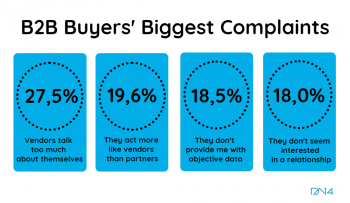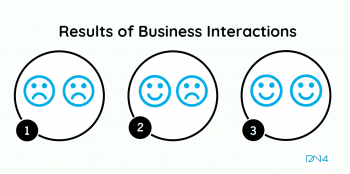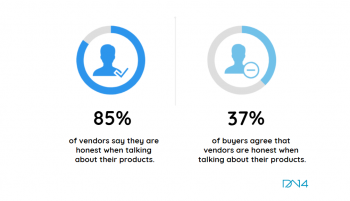Companies take great pains to impact potential B2B clients and push sales. They create impressive ads, and talk a lot about the advantages of their products and services, trying to be convincing. In their attempts to outperform competitors, businesses often ignore the real needs of buyers who are seeking more than just a one-time bargain. They are seeking partners to trust.
This year, research by TrustRadius revealed that tech buyers are reluctant to purchase from vendors who have been “very salesy” when presenting offers. Companies that have the most impact on B2B representatives are those that focus on transparency, trustworthiness, and long-term goals – in other words, that act more like partners than salespeople.
The study underscores that B2B decision-makers prefer open, honest and responsive vendors who are:
- willing to discuss pricing and packaging;
- ready to answer questions and give examples;
- able to present an overview of product features, a custom demo, and a proof of concept;
- consultative and proactive in working out the best approach for the use case;
- able to provide buyers with customer evidence (reviews, case studies);
- helpful in understanding potential ROI;
- eager to support strategic company’s goals.
Another survey among B2B buyers shows that almost 20% of them would like to deal with sales reps who have a partnership in mind and are interested in a long-lasting relationship. At the same time, almost 30% of respondents are vexed by vendors talking too much about themselves.

Market findings of our custom software development company coincide with the conclusions mentioned above. In our research, we’ve tried to learn what influences decisions of top executives when choosing a service provider. Our respondents mention skill set, reasonable pricing, quality of code, and a proactive approach as important signs of qualified providers. Yet, most frequently they refer to:
- prompt and clear communication;
- desire to help and be a part of the project
All these indicate that partnership is a highly sought-after type of interaction between businesses. A win-win partnership, to be more exact – one that results in more money and a better product for both sides.
Business Games: Three Possible Outcomes
The term “win-win” comes from the game theory used to describe how people interact in decision-making situations. Applied to business, “the game” means interactions between companies – be it a negotiation, meeting, dispute, signing a contract, common project, and so on. Each interaction can result in one of three possible outcomes:
- lose-lose — when neither side achieves the desired results. For example, each party loses money, cuts budgets and, on the whole, feels worse off than before the interaction.
- win-lose — when only one party benefits and gains even more than expected at the expense of the other. A classical example is when a buyer insists on the lowest price possible even if a seller loses money. The situation decreases or eliminates the chances of building a long-term business relationship.
- win-win — when all participants benefit from their interaction.

From a short-term perspective, win-lose outcome promises the largest profit — if you win, of course. The downside is that the losers will probably never deal with the winners again.
From a long-term perspective, win-win strategy brings far better results. It ensures strong business ties along with enhanced revenue.
Key Points of a Win-Win Scenario
Many people see a win-win scenario as a chain of compromises, which is not entirely correct. The essence of a win-win approach is that all parties gain more from the cooperation than they would receive otherwise. The long-lasting positive effect of this strategy is based on several fundamentals, such as:
- trust;
- transparency;
- empathy;
- flexibility;
- mutual understanding and respect;
- common business vision, goals, and values.
These things don’t occur all at once and come from nowhere, they take time and effort to develop. However, a win-win partnership is worthwhile, since it fuels business growth.
Here are several basic rules we use in our company to become reliable partners for our clients.
Listen to needs and ask relevant questions
Ancient Greek philosopher Epictetus noted that “We have two ears and one mouth so that we can listen twice as much as we speak”. This old saying is fully relevant to a modern business relationship. Unwillingness to listen is what really annoys European and North American B2B representatives. About two-thirds of them complain of vendors/sales reps who are “more interested in selling their products/services than listening to my needs”.
Dive deeply into everything the other side wants from you. Ask about their hopes, expectations, and unique requirements. The right questions will foster mutual understanding, yet they require in-depth knowledge of your potential partner’s background. Which leads us to the next rule.
Learn more about the industry in question
One-third of B2B representatives get frustrated when a service provider doesn’t understand their company, sector or industry as a whole. It’s highly recommended to find out about your potential partner and their business as much as possible. The more information you have, the better your chances of meeting their expectations.
Let the other side feel that you aren’t just selling something for an agreed upon price. You deliver products and services based on deep understanding of their company, the people behind it and their particular requirements.
Find or develop common values
A common set of values strengthen relationships just as much as mutual benefit. And vice versa, it’s difficult to build a partnership if your ideas about life and ways of doing business are totally different. A green company would have trouble dealing with a supplier who pollutes the environment. A firm promoting a healthy lifestyle will stay away from a cigarette factory.
The more in common you have, the better your chances of creating a successful partnership. Try to find out if you hold similar views about work ethic, family values, social commitment, and other things. You can expand shared on views by developing common goals, starting new projects, or undertaking social responsibility initiatives.
Create a range of options that are profitable for both sides
Knowing your partner’s needs, ambitions, products, and values, you can design a variety of proposals that serve the interests of both sides. When you make multiple offers, you signal your flexibility and strong desire to generate mutual gain. You also have to clearly set your company’s expectations. Make sure that your partner understands what you are going to get from this cooperation.
The following are common examples of win-win practices that have been successfully used while building partnerships:
- a vendor offers a lower price while still keeping a reasonable profit margin and getting valuable experience;
- a service provider proposes reduced rates or a free trial period in exchange for the opportunity to master new technologies and eventually receive a large order;
- a company provides great customer service while keeping their higher price. New research has found that 98% of B2B e-commerce clients in the UK value a high level of customer support more than delivery speed or a competitive price;
- companies exchange information and/or cross-promote each other’s brands (mutual benefit).
Show a high level of openness
A survey of 650 technology buyers and vendors has found a chasm between them. 85% of vendors claim that they are candid about the limitations of their products, while only 37% of buyers agree. Given this, experts advise being “brutally honest” when it comes to your products or services.

It’s greatly helpful to show demos, provide reviews and give case studies demonstrating your benefits. At the same time, don’t try to hide weaknesses or, in case of software development services, bottlenecks that can appear at any stage of the app building process.
A high level of transparency is especially important when partners live in different countries and time zones. Naturally, to feel comfortable your client needs to know what exactly is going on in the other part of the world. Regular updates, prompt communication, timely clarifications and detailed responses will make the process entirely open for your business-friends from afar.
Take a proactive approach
Rather than solve problems, it’s better to prevent them. Taking proactive steps, you can spot and eliminate potential issues. During communication sessions, make sure that you and your partner are still on the same page. Offer better solutions if you see them, help your partner fill gaps and continue asking questions to clear up any doubts.
Write everything down
You should carefully document every single point you have discussed. Not because you don’t trust your partner, but in order to avoid possible misunderstandings. Sometimes it’s hard to keep track of all the things you agree to verbally, especially with remote collaborations. Meeting notes minimize the chances of miscommunication.
Include “if-then promises”
In an ideal world, partners should believe in the promising prospects of their collaboration. In reality, parties often have different assumptions about their future. One side may be too optimistic, while the other perceives the offered scenario as profitable yet unrealistic.
In such cases, experts recommend considering a contingent contract that contains so-called “if-then promises”. In other words, you negotiate steps to be taken under certain conditions. What if the contractor doesn’t meet deadlines? What if the buyer delays payments? What if prices of certain resources suddenly rises? For example, one side can offer a bonus for on-time completion, but charge a penalty for delays.
Adding a contingent contract into your agreement will reduce risks and increase certainty in achieving success.
Separate the issue from the people
In any partnership, you can’t avoid disagreements entirely. What you can do is prevent conflicts from getting out of hand.
Business controversies are often perceived as a personal insult. However, to reject what is said doesn’t mean rejecting the speaker. You can respect people, share their values and appreciate their merits — yet disagree with them over one or two particular points. In such situations, it’s important to eliminate personal battles that cause anger, resentment, or affront. Sometimes it’s better to invite a mediator to resolve disputes.
Think about win-win-win
Partners who appreciate each other can go much further, creating win-win-win situations. Who is the third beneficiary? Your mutual customers. In addressing their problems and producing new benefits for common clients together, you get chances to enhance your impact and expand your customer base not twice, but thrice.
Final Thoughts
A long-lasting business partnership can be very promising. By combining strengths, you can get benefits that exceed your companies’ individual expectations. Unfortunately, collaboration doesn’t always work out. Poor communication, delays in responses and payments, unkept promises, lack of transparency—all these signal that something’s going wrong. If you understand that a relationship isn’t win-win, it’s ok to break away.
However, you should never stop seeking good partners. Those who provide you with new ideas, complementary skill sets, necessary support, and other vital things. Those who see value in working with you. Those who meet your needs—while you meet theirs.



